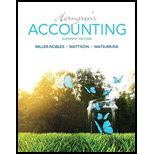
T-account:
A T-Account is the statement presented for the entries made for a particular account. The standard format of a account has two sides for debit and credit entries. Debit entries are entered on the left side and credit entries are entered on the right side.
The Trail balance is the statement pressing the balances of accounts. It has accounts title and their balances (debit or credit). Trial balance is prepared to check the arithmetical accuracy of accounting, as the total of debit side should be equal to the total of credit side.
Net income or Net loss:
The Net income or net loss is calculated to evaluate the profitability of the business; it is calculated with the help of following formula:
1. T accounts for given accounts titles and
To indicate: T accounts for given accounts titles and posting of given entries directly to T accounts
2. Trial Balance as at June 30, 2018:
To indicate: Trial Balance as at June 30, 2018
3. Net income or net loss and recommendation for business continuity:
To indicate: Net income or net loss and recommendation for business continuity
Want to see the full answer?
Check out a sample textbook solution
Chapter 2 Solutions
Horngren's Accounting (11th Edition)
- Can you demonstrate the accurate steps for solving this financial accounting problem with valid procedures?arrow_forwardTom Hale was an entertainment executive who had a fatal accident on a film set. Tom's will directed his executor to distribute his cash and stock to his spouse and his real estate to a church (an “A” charity). The remainder of Tom’s assets were to be placed in trust for three children. Tom’s estate consisted of the following: Assets: Personal assets $ 1,340,000 Cash and stock 26,400,000 Intangible assets (film rights) 83,500,000 Real estate 17,400,000 $ 128,640,000 Liabilities: Mortgage $ 5,600,000 Other liabilities 6,500,000 $ 12,100,000 a. Tom made a taxable gift of $7.50 million in 2011. Compute the estate tax for Tom's estate. (Refer to Exhibit 25-1 and Exhibit 25-2.) Note: Enter your answers in dollars, not millions of dollars. EXHIBIT 25-2 The Exemption Equivalent / Applicable Exclusion Amount Year of Transfer Gift Tax Estate Tax 1986 $500,000 $500,000 1987 1997 600,000 600,000 1998 625,000 625,000 1999 650,000 650,000…arrow_forwardI am looking for help with this general accounting question using proper accounting standards.arrow_forward
- Need help pleasearrow_forwardCan you solve this financial accounting problem with appropriate steps and explanations?arrow_forwardRajiv and Laurie Amin are recent college graduates looking to purchase a new home. They are purchasing a $200,000 home by paying $20,000 down and borrowing the other $180,000 with a 30-year loan secured by the home. The Amins have the option of (1) paying no discount points on the loan and paying interest at 3 percent or (2) paying 1 discount point on the loan and paying interest of 2.5 percent. Both loans require the Amins to make interest-only payments for the first five years. Unless otherwise stated, the Amins itemize deductions irrespective of the amount of interest expense. The Amins are in the 24 percent marginal ordinary income tax bracket. Assume the original facts, except that the amount of the loan is $300,000. What is the break-even point for the Amins for paying the point to get a lower interest rate?arrow_forward
- Can you demonstrate the accurate method for solving this financial accounting question?arrow_forwardI am searching for the correct answer to this general accounting problem with proper accounting rules.arrow_forwardOn November 10 of year 1, Javier purchased a building, including the land it was on, to assemble his new equipment. The total cost of the purchase was $1,200,000; $300,000 was allocated to the basis of the land, and the remaining $900,000 was allocated to the basis of the building. (Use MACRS Table 1, Table 2, Table 3, Table 4 and Table 5.) Note: Do not round intermediate calculations. Round your answers to the nearest whole dollar amount. Problem 10-51 Part e (Static) e. What would be the depreciation for 2024, 2025, and 2026 if the property were nonresidential property purchased and placed in service November 10, 2007 (assume the same original basis)?arrow_forward

 AccountingAccountingISBN:9781337272094Author:WARREN, Carl S., Reeve, James M., Duchac, Jonathan E.Publisher:Cengage Learning,
AccountingAccountingISBN:9781337272094Author:WARREN, Carl S., Reeve, James M., Duchac, Jonathan E.Publisher:Cengage Learning, Accounting Information SystemsAccountingISBN:9781337619202Author:Hall, James A.Publisher:Cengage Learning,
Accounting Information SystemsAccountingISBN:9781337619202Author:Hall, James A.Publisher:Cengage Learning, Horngren's Cost Accounting: A Managerial Emphasis...AccountingISBN:9780134475585Author:Srikant M. Datar, Madhav V. RajanPublisher:PEARSON
Horngren's Cost Accounting: A Managerial Emphasis...AccountingISBN:9780134475585Author:Srikant M. Datar, Madhav V. RajanPublisher:PEARSON Intermediate AccountingAccountingISBN:9781259722660Author:J. David Spiceland, Mark W. Nelson, Wayne M ThomasPublisher:McGraw-Hill Education
Intermediate AccountingAccountingISBN:9781259722660Author:J. David Spiceland, Mark W. Nelson, Wayne M ThomasPublisher:McGraw-Hill Education Financial and Managerial AccountingAccountingISBN:9781259726705Author:John J Wild, Ken W. Shaw, Barbara Chiappetta Fundamental Accounting PrinciplesPublisher:McGraw-Hill Education
Financial and Managerial AccountingAccountingISBN:9781259726705Author:John J Wild, Ken W. Shaw, Barbara Chiappetta Fundamental Accounting PrinciplesPublisher:McGraw-Hill Education





